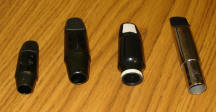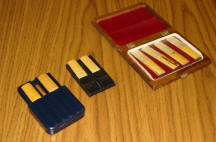|
Saxophone Equipment |
As with any musical instrument, the price of a quality new saxophone is very high. However, with the significantly smaller investment of a new mouthpiece and a quality brand of reeds, great rewards for your student can be gleaned. The following will offer you some options in these areas.
Mouthpieces
Reeds
Horns
Accessories
Mouthpieces
For general, everyday use, a Selmer
C* ("C-star") is a proven classic. Many professionals,
including myself, use this mouthpiece, or a variant of it (the C**, for
example) in classical playing, whether for solo, chamber, or full-ensemble
purposes. Some other popular
mouthpieces include the Selmer S-90 series, the Selmer Larry Teal, the
Rousseau series, or the Vandoren series of mouthpieces.
 All
of these work well on all the members of the saxophone family, and some
companies will allow you to order several at once, try them for a few
days, and send back what you do not want (for a small fee, of course).
All
of these work well on all the members of the saxophone family, and some
companies will allow you to order several at once, try them for a few
days, and send back what you do not want (for a small fee, of course).
For jazz use, you have the choice between hard rubber and metal mouthpieces. For the less experienced student, especially one who does not practice much, try to avoid the metal mouthpiece. These tend to be much less stable and uncontrollable than their hard rubber counterparts, and can easily produce unwanted squeaks and squawks. It takes diligent practice with a metal mouthpiece to get it "under control." Some good hard rubber jazz mouthpieces include Meyer, Otto Link, Berg Larsen, and Claude Lakey. You will have several "facings" to choose from, and the larger the number, the larger the facing (or the opening of the tip). Try to choose a medium number (Meyer 5 or 6, for example, works great for alto players), as they tend to be more similar to the classical mouthpieces with which your students are familiar.
Reeds
Reeds are, unfortunately, a necessary
evil of saxophone playing. A
box of 10 reeds, regardless of the fact that they are of the same strength,
will have 10 completely different-feeling reeds; depending on one's personal
tastes, you are lucky to find five that you really like. Nonetheless,
some brands of reeds are certainly better than others. For classical
playing, I highly recommend the classic Vandoren reeds (in the blue box).
Some other reeds that perform satisfactorily in the classical medium include
Hemke, LaVoz, and Glotin.  For
jazz playing, the following brands/types are popular: Rico Royal, Rico
Jazz Select, Vandoren V-16, Vandoren Java, and LaVoz.
For
jazz playing, the following brands/types are popular: Rico Royal, Rico
Jazz Select, Vandoren V-16, Vandoren Java, and LaVoz.
Reed strength often depends on the individual player, but students should be playing on at least a 2-1/2 strength reed, preferably a 3. (LaVoz reeds are not organized by number but contain indications such as Medium, Medium-Hard, etc., which can roughly correspond to these numbers.) Many students feel that reed strength is an indication of the level of their playing ability, but it certainly is not! Professionals play on reeds that range from 2-1/2 to 4, so try to quash this notion when it rears itself.
Horns
Student-model horns, such as Bundy or Vito, while quite inexpensive in
comparison to better horns, are of very poor quality. There are
several models of intermediate level horns that are satisfactory for the
average student. Some models to consider are the Selmer USA, Yamaha
52 or 62, or Yanagisawa. Several stores are beginning to come out
with their own brands of horns that are very reasonably priced, but I
know little about these specific horns so can make no judgment on them.
There are also lots of "gimmick" horns such as those that are
blue or red in color; again I know little about these models.
For the more serious student who will likely go into college as a music major, a professional-model horn would be a great choice. Horns such as the Selmer Super Action 80 and the Yamaha 875 ("Custom") are the most popular. Keilwerth saxophones are also becoming quite popular, and while I have very limited experience with these, the experience I have had with them has been positive. All of these horns are quite expensive, depending on the store from which you purchase them, but they could potentially last a lifetime, and thus will make a great investment. One option being explored by more and more people is to look for used horns that are frequently posted at on-line auction sites. Selmer Mark VI's are some of the most popular horns ever; since they are no longer made, the only way to obtain one is to buy it used, and the internet is a fabulous way to shop for used horns. While it is quite possible that you may get a "lemon," it is also quite possible that you find a great used horn for a good price.
Accessories
One of the most important accessories is a reed holder that stores
the reeds on a flat surface. The LaVoz Reed Guard will hold 2 or
4 reeds, depending on the model, and is very inexpensive. Vandoren
also makes a relatively inexpensive reed case that stores them in a closed
box. Other reed holders are available, such as containers that will
hold up to 12 reeds and store them on a glass surface.
A neck strap does not need to be anything fancy. Some are
made with padding around the neck area and that is fine. Avoid those
made with elastic around the neck. Though they may feel better to
many students, they allow the horn to move up and down too much.
For the larger horns (tenor and baritone) you may want to consider using
a harness. This fits around the back and goes over the shoulders,
alleviating the pressure on the neck.
For cleaning the horn, a silk swab is the best thing to use.
Avoid the "Pad Saver" that stays in the horn, as it retains
the moisture on the pads and can damage them quickly. There are
also neck swabs and mouthpiece swabs available. Try to get your
students to clean their horns often! It is amazing how much "stuff"
builds up inside the mouthpiece and horn.
All of this equipment should be available from your local music retailer.
There are also lots of nationally-known retailers, such as the Woodwind and Brasswind and Giardinelli.
Happy hunting!
| If you would like to be added to the TSMP Email Mailing List and receive periodic notifications of new articles and updates to this website, then please email TSMP.
The Texas School Music
Project is a source for ideas and information
concerning pedagogical
practices in the music classroom or rehearsal hall. The TSMP is a service provided to
all music specialists by the faculty
of
the Department of Music
at Stephen F. Austin State University. Copyright ? 2002, Department of Music at Stephen F. Austin State University |
